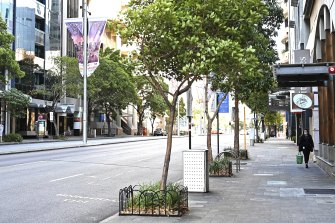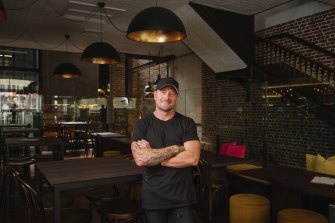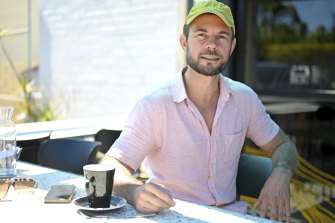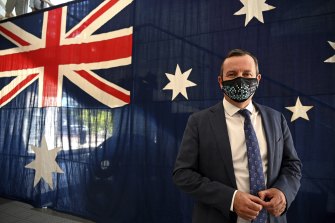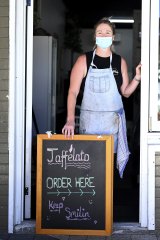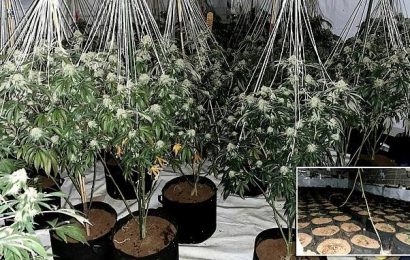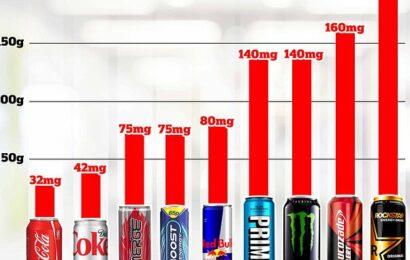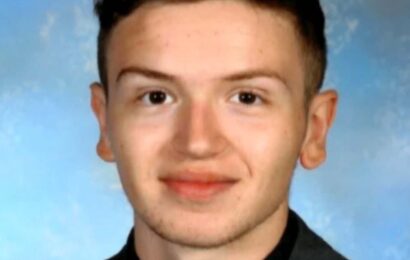For our free coronavirus pandemic coverage, learn more here.
By comparison with the rest of the world, Western Australia remains a mostly COVID-free idyll. Its total active caseload is about 170, it’s had no more than 24 new community cases in any single day this year, and contact tracers are still actively tracking and catching individual cases.
They are features of the pandemic that the eastern states have long left in the rear vision mirror.
The main business strip of St Georges Terrace in Perth’s CBD is as barren as the eastern states’ cities since a mask mandate was brought in. Credit:Peter de Kruijff
But behind the long-closed border, people are worried. The caution of Premier Mark McGowan, a small but persistent outbreak, a mask mandate, and the broadest proof-of-vaccination requirements in the country have many people spooked. Fear of Omicron has become akin to holding a ticking time bomb with a broken timer, never quite knowing when it’s going to go off.
It’s a different story outside the city centre, but in Perth’s CBD, people have been driven off the streets and back into their homes.
The restrictions have won wide public support: a recent poll by the local newspaper, the West Australian, shows 70 per cent of residents think the decision to keep the border closed was the right one. But in some quarters, the consensus is fraying. Big business leaders have had enough: Wesfarmers senior executives have decided to move out of their base in Perth to the east coast while Qantas, Woodside and AFL chairman Richard Goyder has followed suit. They say McGowan’s recent decision to indefinitely postpone the state’s February 5 border opening date has made their jobs unworkable.
But so far, McGowan remains undeterred.
“What we’re trying to do is save West Australian lives in large numbers, especially older West Australians,” he said recently. “Older West Australians: their lives count. Their lives matter.”
‘Instant downturn’
Despite the precautions, fear is spreading. In Perth’s CBD, the streets have become a lot quieter since indoor mask rules were brought in on January 16. Probably half of pedestrians walk around masked even though they are not compulsory outdoors.
The annual Australia Day fireworks only attracted a crowd of 100,000 to the banks of the city’s Swan River – much lower than pre-COVID peaks of 200,000-300,000, despite the relatively light restrictions.
McGowan insistence on 14 days of isolation for close contacts (while most states have moved to seven days) has also prompted a self-imposed lockdown by large companies fearful that one case in the office will shut down operations entirely. This has had immediate impacts on city traders.
Sneakers and Jeans Hospitality Group chief executive Andy Freeman, before indoor mask mandates, at the Pirate Life venue which opened in October.Credit:Shot By Tom
Andy Freeman’s hospitality group, Sneakers and Jeans, runs six venues in the city, with a staff of more than 150 people. He says the new mask rule had meant an instant downturn in business.
“So all the large [office] towers, when the mask mandate came out two weeks ago, by Monday they started working from home,” he says.
Freeman, who opened a new Pirate Life beer branded brewpub in the CBD in October, said the group was now operating in the unknown after McGowan’s reopening delay.
“What’s happening at the moment, there’s no visibility and it’s scary … our big concern is people choosing not to come out. I can’t control that if they’re scared and apprehensive,” Freeman says.
“We started weeks ago conserving funds and making changes, reducing expenses, putting in plans for a variety of scenarios depending on what the outcomes of McGowan’s decisions and the landing of Omicron in our market.
“I ordered a few hundred rapid antigen tests for our business. We split our office into three teams and our operations teams into two teams … we have scenarios for 50 per cent downturn, 75 per cent downturn.”
Switching to providing mobile food or shutting down all together are options depending on when the virus starts impacting each bar and restaurant in the group.
‘Wait until the peak’
Outside of Perth’s centre the threat of Omicron has not yet hit as hard.
In hipster Fremantle, Paul Ryan was enjoying a coffee in the sun last week and saying COVID had made his neighbourhood thrive.
Fremantle man Paul Ryan enjoys a coffee before restrictions are expected to come into force in WA.Credit:Peter de Kruijff
“The cafes are absolutely thumping, the nightlife’s just really picked up and the community has sort of bonded together,” he says. “We’re lucky we just haven’t had the virus here yet, it’s coming now so it will be interesting to see what happens.”
Ryan runs a co-working space with different creatives but was not too worried about how they would deal with close contacts or positive cases. He says he is fine with the border opening being delayed. In fact, he says McGowan should have imposed a lockdown to squash the current outbreak.
“Now it seems to be totally out of the bag,” Ryan says. “You may as well wait until the peak passes in the eastern states and then open up.”
Whether or not they believe the Premier should have stuck with the February 5 opening day, a feeling of uncertainty has a firm grip among West Australians. Before Omicron, the high vaccination rate reassured people that WA would be able to enjoy McGowan’s planned “soft landing”. Masks would have only been required in some settings.
Now, as Omicron has ravaged the NSW and Victorian health systems, the large number of cases “over east” prompted a rethink.
But UWA mathematician Professor George Milne, who prepared Delta modelling for WA Health last year but released his own Omicron modelling separately from the government’s last week, says there may not be much point in holding off on a border reopening.
He says by roughly mid-February WA will have the best immunity coverage it will get. His modelling estimates 430 beds would be needed for WA’s peak hospital demand about six weeks after borders reopened.
“A lower number of people in hospital with Omicron will be in the ICU, about half of the number that would be there with Delta,” he says. “About 10 per cent of the 430 people will be in ICU at the peak of hospitalisations, so 43 beds will be taken in total, for a period of about two weeks before the curve drops down again.”
The state government has not commented about whether its Omicron modelling is similar but the Premier is reluctant to open and let in a wave of cases from other states while they are peaking.
Controlled spread
McGowan hopes it could be weeks before the case numbers jump dramatically in his state – as long as West Australians keep getting tested. Testing figures, however, have been lower than the government wanted throughout January.
Lockdowns last year saw testing highs of up to 18,000 swabs on a single day but over the course of January the average number of tests daily has been a much lower 5000, even though more than 140 people are self-isolating with COVID-19 and more than 100 exposure sites have been named throughout Perth and country regions.
WA Premier Mark McGowan’s state will be the last to open up to the rest of the country.Credit:Peter de Kruijff
Cases are now popping up at nightclubs in Perth – the type of venues that have served as superspreader events in other parts of Australia and the globe – and McGowan has warned the current outbreak cannot be stopped, only subdued.
Jaffelato owner Ali Richards, whose Rockingham cafe saw its trade increase during the COVID-19 pandemic.Credit:Peter de Kruijff
The number of deaths and ICU presentations attributable to the Delta strain around Australia is not known but McGowan said anyone who thought things in WA would be all “sweetness and light” when the virus started to spread was wrong.
“There will be lots of issues and lots of problems and lots of people will get sick,” he said.
In McGowan’s electorate of Rockingham, Ali Richards runs a cafe near the southern suburb’s foreshore. Jaffelato has been busier since the pandemic started, with takeaway sales going through the roof, but having positive COVID cases among the small team of staff will likely mean the business will have to close at times.
“I’m pretty understanding we will need for it to go through. It would be lovely if we could take it through the population in a controlled way,” Richards says. “NSW seems to be one extreme, whereas South Australia seems to be managing it in a different way.” Indeed, South Australia – which has restrictions on dancing, elective surgery, home gatherings and customer capacity – has been observed closely by WA as it has brought its caseload down after a dramatic rise in December.
It went from eight cases on December 10, when it first recorded a community case of Omicron, to 73 in just over a week. Tougher restrictions were brought in on December 27 after it recorded 842 cases.
McGowan has said restrictions would be brought into WA much sooner than in South Australia, which has had more than 110 COVID-19 deaths since the start of the year. But what those restrictions will be – and when they are implemented – is still up in the air.
Meanwhile, the Premier has forecast that the surge capacity of 800 contact tracers would eventually be overwhelmed and definitions of close contacts would be loosened to be more in line with the national approach. Isolation periods would fall then from 14 days to seven.
He has also promised more compassionate treatment after February 5 for West Australians stuck outside the state, and in the next two weeks he could come back with a decision on a new reopening. Until then, West Australians are stuck in a cautious state imposing a shadow lockdown on itself.
The Morning Edition newsletter is our guide to the day’s most important and interesting stories, analysis and insights. Sign up here.
Most Viewed in National
From our partners
Source: Read Full Article
